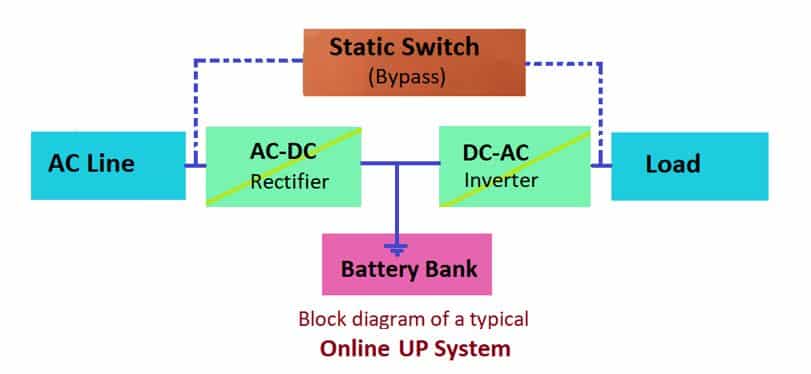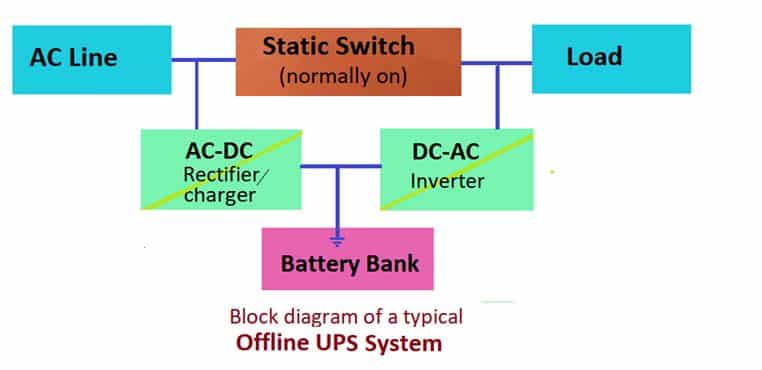UPS or Uninterruptible Power Supply is a device that is designed to supply continuous power to critical loads that must run without interruption. UPS system continues its operation even during a power outage, suppresses line transients, and harmonic distortions in the power supply.
The UPS system should have the following ideal features.
- Regulated sinusoidal output with total harmonic distortion (TDH) is independent of the changes in load or input voltage, linear or non-linear, balanced or unbalanced.
- It should have high reliability and, low maintenance.
- Low TDH sinusoidal input current and unity power factor (PF).
- High efficiency, low cost.
- Less weight, and size.
- Low electromagnetic interference (EMI) and noise.
Types of UPS systems
UPSs are classified into several categories. Offline and online UPS system configurations are part of a static UPS system depending on their functionality and operated on power semiconductor electronic devices.
- Online UPS
- Offline UPS
Online UPS System

Online UPSs are used to provide uninterrupted power. Unlike offline UPSs, online UPSs do not connect utility power to the outlet. The rectifier-inverter combination supplies AC to the load, simultaneously charging the battery. When there is an interruption Online UPSs can provide uninterruptible power without any transfer delay as their battery is always connected to the inverter through which the load is supplied even in normal operation.
The static transfer switch in an online UPSs is normally off. It is only used when there is an overload condition or when the connected motor draws a high inrush current. In such a situation, the power electronic circuit associated with the static switch detects the high current and transfers the power from the inverter to the main power. This prevents possible damage to the UP’s internal hardware.
In an online UPS system, there would be no transfer time on online UPSs. These are also called double conversion UPS, since the AC input is converted to DC by the rectifier, and then back to AC by the inverter. In online UPSs, the rectifier must supply power to the load as well as to the battery bank for the load. Therefore, the rectifier must handle a higher load and online UPSs usually come with large heat sinks.
Advantages of Online UPS systems
- A UPS that operates online does not require any transfer time because the battery is always connected to the load.
- Although used for applications using more than 10 kW, with the dramatic advancement in technology and cost reduction, online UPSs are now available for devices even less than 500 W.
- The cost of online UPS is higher as the rectifier is designed to handle high power for simultaneous load and load supply.
Disadvantages of Online UPS
- The UPS topology described above has a poor transient response to the load changes.
- There is a possible high acoustic noise from the transformer.
Offline UPS System

The Off-Line UPS is called that because the inverter is outside the main path of the current, and it is called Stand-By because the inverter is off, “waiting” for it to be required to turn on.
The term offline means that the battery bank is not connected (offline to the load in normal operation when main power is available. In this situation, the main power is connected directly to the load output through a static transfer switch that is normally on. When mains power is available, the backup bank is charged by DC through a charger unit consisting of a rectifier circuit.
In a power outage or surge, the static switch disconnects the main power to the load and connects the battery to the load in a negligible amount of time. This transfer time from mains to the battery is usually 10 to 25 ms and depends on the semiconductor or power electronic circuit that detects the loss of mains power and performs the switching.
Since the utility power is directly connected to the load in normal operation, any distortion such as spikes, sags, and noise on the utility appears at the UPS output. However, some UPS systems perform a form of power conditioning on the output. Line-interactive UPSs are a special type of offline UPS that deal with small over-voltages or under voltages that occur on the network. They employ a multi-tapped autotransformer or a boost transformer to convert the input mains voltage to the correct output voltage.
Advantages of Offline UPS
- Offline UPSs are the cheapest among all UPS systems as they have the simplest design.
Disadvantages of Offline UPS
- As there is unavoidable switching time in offline UPSs, there is an obvious power blackout in connected loads. Therefore, this type of UPS is used with loads such as desktop computers, printers emergency lighting circuits, etc., which can handle such a small blackout.